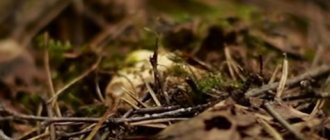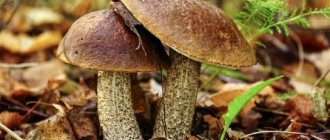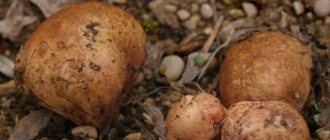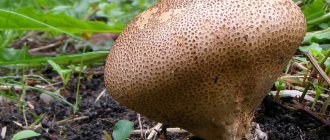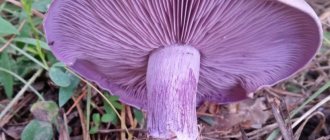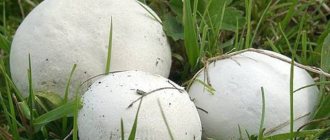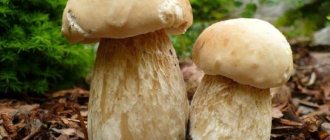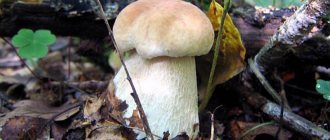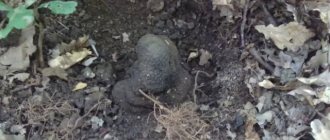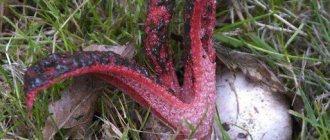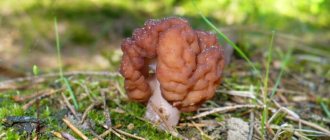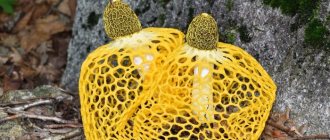If you think that in order to go into the forest to pick mushrooms you need to wait until the second half of summer or the beginning of autumn, you are deeply mistaken. And besides chanterelles, boletuses, honey mushrooms and boletus mushrooms, there are a huge variety of tasty and healthy mushrooms that are in a hurry to be born with the first warm days.
There are a huge number of types of mushrooms that can be found in the first half of summer. The most original of them are early hygrophorus, bear's ears, globose sarcosoma, May rows and morel mushrooms.
Let's take a closer look at mushrooms, which are rightfully considered natural indicators of not only atmospheric air, but also soil cover. After all, they grow only where the degree of contamination with toxic substances is negligible, which means the environmental situation is good. These mushrooms have a rather strange appearance, and an equally strange name - bear ears, but for some reason mushroom pickers recommend being patient and going into the forest in search of them.
Description, properties, features
The mushrooms Sarcoscypha coccinea have other names - elf's bowl, scarlet elf's bowl, and Belarusians call them granny's ears. Beautiful and interesting bear ears are very rare; they grow mainly in the north of the Irkutsk region. Here you can find mushrooms growing in large clusters, but sometimes mushrooms grow alone. You can find a circle of growing mushrooms, and most of them will be located strictly along the circumference.
Such very strange names for mushrooms were not given by chance, the fact is that the mushroom really looks like an ear, its stem is short, sometimes it may seem that it is not there at all. Their color can be different - red, orange, earthy gray. The leg is short, sometimes it may seem that it is not there at all.
You won’t find clearly defined spores in the mushroom, but on the ground, under the bear’s ear, there will be brownish-yellow dust.
Bear ears grow only in ecologically clean areas and are not considered dangerous, like most representatives of the mushroom kingdom, which have the ability to accumulate toxic substances. The main thing is not to make the wrong choice and not mistake the toadstool for an edible mushroom, although it is not so easy to confuse a toadstool with a bear's ear. Beginner mushroom pickers should be especially careful, since they have little experience in identifying mushrooms. We would advise beginners going into the forest to get an elven cup to take with them a photo of the mushroom and its description, and then the likelihood of error will be zero.
Giant champignon or Lagermania gigantea
One of the largest mushrooms in the world is a member of the champignon family, Lagermania gigantea. This unique mushroom can often be found in the steppes and meadows of central Russia. It has no legs, and the mushroom body itself looks like a huge round egg, lost by an extinct dinosaur, or someone’s head, for which the mushroom is popularly called “bighead.” And because bigheads appear during the rainy season, they are called raincoats.
Who should avoid eating mushrooms?
Mushrooms are not recommended for consumption by children under 12 years of age, pregnant and lactating women, as well as people suffering from gastrointestinal diseases. Small portions of mushrooms are good for a healthy person, as this product contains a large amount of vitamins, minerals and trace elements.
Excessive consumption of mushrooms is fraught with negative consequences for the body. Malfunctions in the gastrointestinal tract, urinary system, and disruption of the functioning of other organs and systems may occur. Mushroom intoxication can be a consequence not only of the consumption of conditionally edible mushrooms, but also as a result of the fact that the cooking technique has been violated.
Children suffer especially hard from mushroom poisoning. The first signs of poisoning in children will appear within 4 hours after eating. The first signal is nausea, then diarrhea and vomiting occur. It is very important to consult a doctor in a timely manner and be able to distinguish mushroom poisoning from a common intestinal disorder.
Purple miracle amethyst lacquer
At the end of summer, in the forests, in damp meadows, amethyst varnish (also known as purple) grows - small mushrooms on a thin stalk with an outstretched cap. The mushroom body is completely painted in lilac-violet color, even the plates under the cap, which smoothly descend to the stem, the only thing is that in old specimens they fade. The edible tender pulp is also purple, with a pleasant taste and smell.
The poisonous mushroom Mycena purea is very similar to old lacquer mushrooms. You can distinguish it by the characteristic unpleasant smell of radish and the plates of pure white color (in the amethyst varnish they are slightly purple).
We cook deliciously
- Mushrooms fried with sour cream. Sort the mushrooms, rinse, boil, drain in a colander, and drain. In a deep frying pan, saute the onion, add mushrooms cut into pieces, and simmer under the lid until tender. You can add herbs, sour cream, bay leaf, salt and black pepper to taste.
- Mushrooms fried with potatoes. Boil the mushrooms and drain in a colander. Heat vegetable oil in a frying pan or saucepan, place the onion on it and fry it until golden brown. At this time, you need to cut the mushrooms into pieces and add them to the onions for frying. When the mushrooms are covered with a golden brown crust, peeled and diced potatoes are added to them. Add a little water or mushroom broth, cover with a lid and leave over medium heat until fully cooked. At the end of cooking, you can add a little sour cream, herbs, salt and black pepper to taste.
Use in cooking
Chinese mushrooms are both an independent product and an essential ingredient in a large number of oriental dishes. In addition to medicinal qualities, they have many beneficial culinary properties. Their taste is delicate, and their aroma is rich and unusual.
Judas's ear goes well with any food. Boiled or fried, it is included in salads, soups, cold appetizers, meat and fish dishes.
In dried form, “tree ears” are used as a seasoning. Since the Chinese delicacy contains few calories, Auricularia auricularis is also used in dietary dishes.
How to cook
The muer tree mushroom has an unusual feature - if you place it in water, it will begin to “grow” and increase almost 10 times in size, and then take on its original appearance. This property of the mushroom should be taken into account when preparing it. Before preparing the tree ears, they must be soaked in water for at least 1 hour. The water is drained several times.
Muer does not require immediate cooking, but can be stored for a short time after soaking. Most often it is sent to the refrigerator for a day or stored for several hours in a cool, dry place.
How to brew
The Judas's ear mushroom requires careful heat treatment, so it should be cooked for at least two hours. When boiled, it should be added to soups and salads.
They even fry muer only after they have been subjected to many hours of heat treatment. Dried muers are also boiled; drying the abalone is not enough to put it into a dish in this form.
But if you grind them into powder, no heat treatment is required. In this form, “wood ears” are used only as a seasoning.
Interesting cooking recipes
The muer tree mushroom, recipes for which are in every cookbook of oriental cuisine, is wonderful when fried. Most often, muer is sold in a small black package. Before cooking, remove the packaging and place the mushrooms in water. They will soon swell. For frying you will need only 300 g of product.
While the “tree ears” are in the water, they are cut for frying.
- 4 carrots,
- 2 onions
- 2 cloves of garlic.
Preparation
- Pour vegetable oil into a heated frying pan and fry the vegetables for 10 minutes.
- Then remove the pan from the heat a little and add the mushrooms to it.
- Fill with water, close the lid and simmer for another 2 minutes.
- The dish is ready.
You can season it with sauce or seasoning to taste.
In Korea and China, salad with “wood ear” is often prepared. To do this, fry the red pepper, add a little oil to the pan and add mushrooms. Fry for another 2-3 minutes.
Then put it on a plate, add onions, coriander, aromatic herbs and various seasonings to taste. Season the salad with soy sauce or vinegar.
Boletuses, saffron milk caps and their properties
Not all orange mushrooms look like illustrations from a science fiction novel. A bright orange cap is characteristic of the boletus (although it can be paler, that is, yellow, or brighter, even red). This mushroom grows in both deciduous and pine and mixed forests. As the name implies, it can most often be found under young aspen trees, but it is also found under pine and birch trees.
The boletus is a rather large mushroom, the diameter of its cap can be up to 30 cm. But the flesh of the mushroom is white, usually slightly pink at the break, but over time it turns green and then turns black. This mushroom does not have a pronounced taste or smell. But it has a unique composition of amino acids, and in addition, it contains a lot of proteins (and in many ways the proteins in mushrooms are similar to proteins of animal origin, but are less digestible, and those contained in boletus are contraindicated for people with chronic liver disease). Boletuses are either dried or cooked fresh; this mushroom cannot be stored. More protein is retained in a fresh product.
Camelina is another orange variety of edible mushroom that is deservedly popular. It is usually found in pine forests. The cap of saffron milk caps is large, up to 15 cm in diameter. It has a bright orange or reddish hue. Fresh saffron milk caps secrete milky juice in large quantities, although it is not caustic. Ryzhiki are valued for their delicate taste and aroma; many traditional Russian dishes are prepared with them, some of which are not even seasoned.
Place of growth
The true saffron milkweed grows mainly in the central and northern parts of the country. It is found abundantly in the Urals, Siberia and southern mountainous regions.
For optimal growth of the fungus, a warm temperature regime of 15 to 27 degrees Celsius is required. Saffron milk caps grow in groups, forming a symbiosis with coniferous trees. They do not like shade and very wet soil; they prefer sandy loam soil.
The true camelina is found in the following places:
- coniferous forest;
- spruce or pine young growth;
- mixed forest;
- deciduous forest with spotty growth of pines and spruces.
Woman's ear.
When collecting camelina, you should pay special attention to the sides of forest roads, field edges, clearings and hills. These are his favorite places to grow! Often families of saffron milk caps coexist with butterflies.
Bear ears: delicate aroma and bright colors
There are exotic-looking mushrooms that are popularly called bear ears. In fact, their correct name is Sarcoscipha scarlet. It doesn’t sound very appetizing, although the “bear’s ear” does not arouse any particular enthusiasm among gourmets. There are also other, more romantic, versions of the name in literature - for example, the scarlet elf bowl. In any case, these are edible marsupial mushrooms. They are distributed throughout the world and were well known even before botanists gave them a scientific description in 1772. Bear ears are found in Europe, North America, and even Africa and Asia.
Where does it grow?
This mushroom culture can be found in any region of the country with a temperate climate. It grows in the forest zone (coniferous, deciduous, mixed forests), in particular at the edge of the forest, more often it can be found near swamps and reservoirs, and rarely found in meadows. Tapinella panus grows on a bed of moss, on dead tree trunks and their rhizomes. The eared piglet spores on the wooden supports of old buildings. With its growth, the crop provokes the destruction of the tree. Most often found in large families, single specimens are less common.
How ear-shaped pigs grow.
Podabricots and their properties
What are the names of the mushrooms that grow under apricots? In everyday life, these are, of course, podabrikosoviki. But they also have a scientific name - garden entoloma. Moreover, although their very popular name is associated with the orange, appetizing apricot fruit, in fact the caps of these mushrooms are whitish-gray, or less often, brownish-gray. But the plates are distinguished by a dirty pink tint. As the mushroom ages, it becomes more and more bright, and then the plates even turn red.
These are conditionally edible mushrooms. They have dense and rather fibrous flesh. Some people believe that such mushrooms can cause poisoning. In fact, not all varieties of entoloma have been well studied, so some kind of bobwhite may turn out to be harmless. However, it grows not only under apricots, but also under other fruit trees.
Entolomas grow not only under apricots. Although this mushroom is considered a garden mushroom, it can also be found in the forest - under oaks, birches and rowan trees, wherever there is soil rich in nutrients. In urban environments it can grow directly on the lawn. In the garden it grows under apple trees, pears and rose bushes. Most often, large accumulations of this fungus are found; it appears alone very rarely.
Storing Vorovushka funnel-shaped
Before preparing for long-term storage, talkers It is advisable to use young mushrooms (they are smaller in size, elastic, the color is uniform, light, and the tissues are little damaged). The talkers must be cleared of forest debris; it is better to cut off all damaged areas. Wormy mushrooms are not suitable for cooking. Then the talkers are thoroughly washed with warm water (you can even soak them - leave them in a container with water for 10 minutes) and dry.
Before marinating or salting, Govorushki must be boiled.
When marinating Govorushka mushrooms, it is important to ensure the sterility of the dishes and use a fairly strong marinade (necessarily using acetic acid).
Poisonous mushrooms
Not all orange mushrooms can be eaten. Poisonous ones include, for example, the false chanterelle. Its second name is orange talker. It differs from a real chanterelle in its hat, or more precisely, in its shade and edges. If real chanterelles are always light yellow, then the talker has a reddish-orange tint (sometimes it can be even brighter, copper). In appearance, such a mushroom resembles a funnel with an almost smooth edge, while in a real chanterelle it is always curved. Its leg grows up to 10 cm and usually has a shape narrowed downward.
Talking chanterelles differ from real chanterelles not only in appearance, but also in smell. Chanterelles have a characteristic aroma with fruity notes. False chanterelles have an unpleasant odor.
Leafing through the atlas of mushrooms, you can find another poisonous variety with a bright color. This is an orange-red web spider. It is also known by other names - for example, mountain or plush web. These are inedible and, moreover, deadly mushrooms. They really are orange in color. They can also be distinguished by their characteristic cap, which resembles a hemisphere (as it grows, it becomes flat with a drooping edge). The plates of the mushroom are thick and wide. They are also colored orange. The surface of the cap is dry and has a matte, fine-scaled texture. There is usually a small tubercle in the central part of the cap. The stem of the mushroom tapers towards the base. But it has a lighter shade, even lemon yellow.
How dangerous is the spider web mushroom? It contains a very strong toxin that can even be fatal. But at the same time, the toxin does not act immediately, but after some time (a rather long period of time may pass - about 5-14 days after consumption). These are perhaps the most poisonous mushrooms in Russia. The toxin they contain cannot be destroyed by any heat treatment, be it boiling, drying or frying. Poisoning manifests itself in quite painful symptoms. First, a person is tormented by almost unbearable thirst, then severe abdominal pain may appear, and if measures are not taken in time, toxins can irreversibly affect the functioning of the liver. Medicine knows of cases where a person survived after being poisoned by spider webs, but then was forced to undergo treatment for the consequences for a long time, at least a year.
Interestingly, not all spider webs are poisonous, although many varieties have a bright, beautiful hue. However, the nutritional value of even the conditionally edible spider web is low, its taste is not pronounced, and there is no special aroma (poisonous varieties have an unpleasant odor). But distinguishing a poisonous variety from an edible one can be difficult even for an experienced person. Therefore, it is advisable not to collect such mushrooms at all, so as not to be exposed to unnecessary risks.
How to Plant Sheep Ears
Selecting a location
The plant develops its foliage best and displays its decorative properties in places exposed to the sun. The soil needs to be loose, with good drainage and moderate fertility. The poorer the soil, the smaller and silverier the foliage.
Preparing the soil for planting
The selected area is dug up using the bayonet of a shovel; when digging, add a bucket of sand per square meter to the heavy soil. If the soil is acidic, you can add kg of chalk per square meter. meter. For sheep ears, neutral or slightly acidic soil is preferable. In very poor soil, you can add 5-6 kg of rotted humus or compost. Adding 40 g of superphosphate and 20 g of potassium sulfate per 1 square meter. will also have a beneficial effect on the planted plant.
Planting methods: seeds in open ground and through seedlings
Sheep ears tolerate frost well. You can sow the seeds in the fall. To do this, you need to make grooves in the prepared soil immediately after collecting the seeds. Sow the seeds and cover them with soil. After 8-10 days, shoots will appear. Before winter, the plant will have time to grow a rosette of leaves. As a rule, it overwinters without shelter.
At the end of May, the plant can be planted in a permanent place. When grown through seedlings, the seeds are sown in boxes at the end of March and planted in the ground at the end of May. Leave a distance of 15–20 cm between the bushes. After planting, the plant needs to be watered.
Planting with nodules
Nodules can also be planted in autumn and spring. The holes are made at a distance of 15 - 20 cm, the distance between the rows of holes is about 50 - 60 cm. The depth of the holes is 6-7 cm. Nodules sprout in about 10 - 14 days.
Planting by cuttings
For rooting, cuttings with two to three leaves are cut. Prepare a mixture of peat and sand, moisten it and deepen the cuttings to 1/3 of their length. After about 21 days, rooting will begin. Rooted cuttings are planted in a permanent place the following spring.
Planting by division
Once every 3-4 years, the mother bushes need to be dug up. This can be done not only in spring, but also in summer and autumn. Divide the plant into 2-3 parts and plant it in a new place. The survival rate of Stachys is very high. After transplanting, new bushes require moderate watering.
